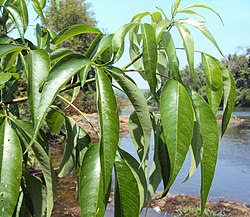| Crateva magna | |
|---|---|
 | |
 | |
| Scientific classification | |
| Kingdom: | Plantae |
| Clade: | Tracheophytes |
| Clade: | Angiosperms |
| Clade: | Eudicots |
| Clade: | Rosids |
| Order: | Brassicales |
| Family: | Capparaceae |
| Genus: | Crateva |
| Species: | C. magna |
| Binomial name | |
| Crateva magna | |
| Synonyms [1] | |
| |
Crateva magna is a species of flowering plant in the family Capparaceae . [1] [2]
Contents
It is a small wild or cultivated tree native to Bangladesh, Borneo, Cambodia, China, India, Indonesia, Japan, Java, Laos, Malaysia, Myanmar, Thailand, Tibet, and Vietnam. [1] [3] It is often found along streams, [4] and also in dry, deep boulder formations in Sub-Himalayan tracts.
Crateva nurvala is now generally considered to be a synonym of this species. [5]